
It’s tough being a teenager. Tough on parents, too – especially when they have to pay for their teen’s car insurance.
Research shows that insurers have little mercy, though. Over the last several years, insurance rates for young drivers have risen 50%.
These days, a 16-year-old might have to pay more than $7,200 a year for full-coverage auto insurance, according to CarInsurance.com. Of course, with time, that dollar figure will come down, and by the time they reach 25, they’ll pay $2,010. Still, all added up, that’s nearly $38,000 it could cost whoever is paying for the insurance policy.
Actuaries – the people at insurance companies who determine risk – aren’t trying to line their companies’ pockets, but merely playing the odds so their company doesn’t lose on its bets. A 16-year-old given a set of car keys is a dicey proposition, as any of us know.
Still, there are ways that parents can lower both the risk that their young drivers face as well as lower the cost of paying for the risks those actuaries think are clear and present.
My mama told me, you better shop around
In the insurance world, companies may monitor what the others do, but they each take multiple variables into account when weighting risk, which can lead to different costs. Some may think age is a bigger risk than credit score while another may think about the make and model of the car or how many miles it’s rung up.
And because of the variations of factors, Kate Long, a consumer financial wellness advocate at Assurance IQ, says consumers shouldn’t just jump at the first rate they’re pitched – especially when there’s a younger driver involved.
Long says that for new drivers, gender is also a factor. “Most states do take this into account for car insurance rates and men tend to pay higher premiums than women because insurers consider them to be higher risk,” she told ConsumerAffairs, pointing to a study by The National Highway Traffic Safety Administration (NHTSA) which reported that male drivers were more likely to be speeding in speeding-related fatal crashes than female drivers.
Long suggests that before you pick out a car for your young driver, you should consider the types of vehicles that will impact the insurance premiums the most.
“The cost to repair is one major factor in determining premiums," she said. "For example, hybrid and electric vehicles can be more expensive to insure than other cars because they can be more expensive to repair, and some require specialty mechanics to complete repairs. Older vehicles cost less to repair than newer, more expensive vehicles.”
But, remember that if you’re going to shop things around, make sure you shop the same factors with each insurer, Mark Snyder, principal consultant and claims subject matter expert at Hi Marley, suggested. That will ensure you’ll get the best deal possible.
“And, don’t forget to explore increasing auto collision and comprehensive deductibles as a potential strategy," Snyder said. "Identifying opportunities to bundle homeowners coverage with auto and umbrella coverages, or qualify for additional household discounts is a good strategy, too.”
You can also use ConsumerAffairs comparative analysis of auto insurance companies, rates, etc. including who’s our research team’s pick for young drivers and a special "how to get cheap insurance" report.
Good grades, off at college, monitoring programs
There are other things parents can do to lower their kid’s insurance costs, too. ConsumerAffairs auto insurance expert Chris Butsch says one is to enroll in the insurance provider’s driver monitoring (“telematics”) program.
Most major providers have a program that monitors a person’s driving behavior and rewards them with as much as a 30% discount for safe driving. Sometimes, there’s even a discount just for signing up.
But, no good deed goes unpunished, as Cassie Sheets, data insights writer at Insurify, reminded ConsumerAffairs. “The downside is that poor driving is penalized with higher rates. Teenagers are still learning. They’re more likely to make mistakes like bumping into the mailbox or sudden braking, which could drive up premiums."
Sheets says that younger drivers can do more than just be a safe driver to reduce premiums.
“Many insurers offer discounts to good students, and the savings can be significant. State Farm offers up to 25% off for high grades or test scores. GEICO offers up to 15% off, and Progressive’s discount is around 10%,” she said.
Sticking with the subject of school, she said that some insurance companies also provide away-at-school discounts for college students who don’t drive during the semester.
Photo Credit: Consumer Affairs News Department Images
Posted: 2024-01-08 12:08:14


















